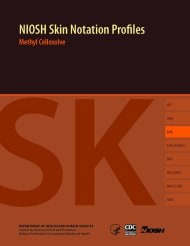NIOSH Skin Notation Profiles: Methyl Cellosolve
April 2011
DHHS (NIOSH) Publication Number 2011-151

As the largest organ of the body, the skin performs multiple critical functions, such as serving as the primary barrier to the external environment. For this reason, the skin is often exposed to potentially hazardous agents, including chemicals, which may contribute to the onset of a spectrum of adverse health effects ranging from localized damage (e.g., irritant contact dermatitis and corrosion) to induction of immune-mediated responses (e.g., allergic contact dermatitis and pulmonary responses), or systemic toxicity (e.g., neurotoxicity and hepatoxicity). Understanding the hazards related to skin contact with chemicals is a critical component of modern occupational safety and health programs.
In 2009, the National Institute for Occupational Safety and Health (NIOSH) published Current Intelligence Bulletin (CIB) 61: A Strategy for Assigning New NIOSH Skin Notations [NIOSH 2009–147]. This document provides the scientific rationale and framework for the assignment of multiple hazard-specific skin notations (SK) that clearly distinguish between the systemic effects, direct (localized) effects, and immune-mediated responses caused by skin contact with chemicals. The key step within assignment of the hazard-specific SK is the determination of a substance’s hazard potential, or its potential for causing adverse health effects as a result of skin exposure. This determination entails a health hazard identification process that involves use of the following:
- Scientific data on the physicochemical properties of a chemical
- Data on human exposures and health effects
- Empirical data from in vivo and in vitro laboratory testing
- Computational techniques, including predictive algorithms and mathematical models that describe a selected process (e.g., skin permeation) by means of analytical or numerical methods.
This Skin Notation Profile provides the SK assignment and supportive data for methyl cellosolve (CAS No. 109–86–4). In particular, this document evaluates and summarizes the literature describing the substance’s hazard potential and its assessment according to the scientific rationale and framework outlined in CIB 61. In meeting this objective, this Skin Notation Profile intends to inform the audience—mostly occupational health practitioners, researchers, policy- and decision-makers, employers, and workers in potentially hazardous workplaces—so that improved risk-management practices may be developed to better protect workers from the risks of skin contact with the chemical of interest.
NIOSH Skin Notation Profiles: Methyl Cellosolve [PDF – 722 KB]
